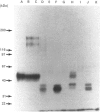Abstract
Insulin-like growth factors (IGFs) circulate predominantly in a growth-hormone-dependent ternary complex of 125-150 kDa. This study investigates the production of the alpha-subunit of this complex, an acid-labile glycoprotein without intrinsic IGF-binding activity, which binds to the IGF-binding protein IGFBP-3 in the presence of IGFs. Medium conditioned by primary cultures of rat hepatocytes produced alpha-subunit with similar complex-forming activity to purified rat serum alpha-subunit. Bovine growth hormone stimulated hepatocyte production of both IGF-I and alpha-subunit. IGF-I tracer bound to pure rat IGFBP-3 was converted from approx. 60 kDa to 150 kDa by serum alpha-subunit, whole rat serum or rat hepatocyte culture medium; this converting activity was destroyed by transient acidification. In contrast, IGF-I bound to hepatocyte-medium IGF-binding proteins could not be converted into a high-molecular-mass from by purified rat serum alpha-subunit. Rat serum and hepatocyte-medium alpha-subunit appeared identical by electrophoretic analysis, since reaction of either with cross-linked IGF-I.IGFBP-3 tracer resulted in bands of molecular mass 130 kDa and 160 kDa, probably representing intact and partially deglycosylated complexes. However, IGF-binding proteins in rat serum and hepatocyte medium were different, in that affinity labelling of medium binding proteins, depleted of endogenous IGFs, showed no evidence of the 50-60 kDa cluster of bands characteristic of rat serum IGFBP-3. We conclude that rat hepatocytes in primary culture produce alpha-subunit similar to that in rat serum; however, alpha-subunit is unable to form ternary complexes with hepatocyte IGF-binding proteins, since cultured hepatocytes do not secrete IGFBP-3.
Full text
PDF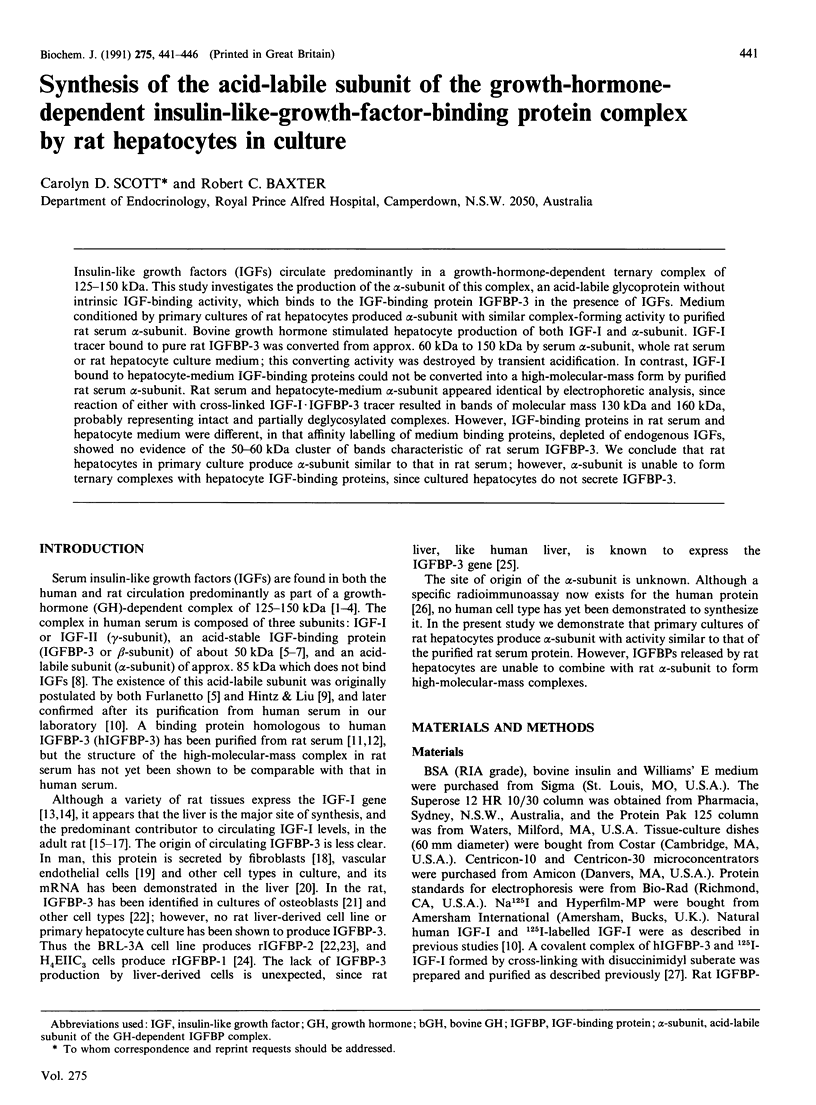
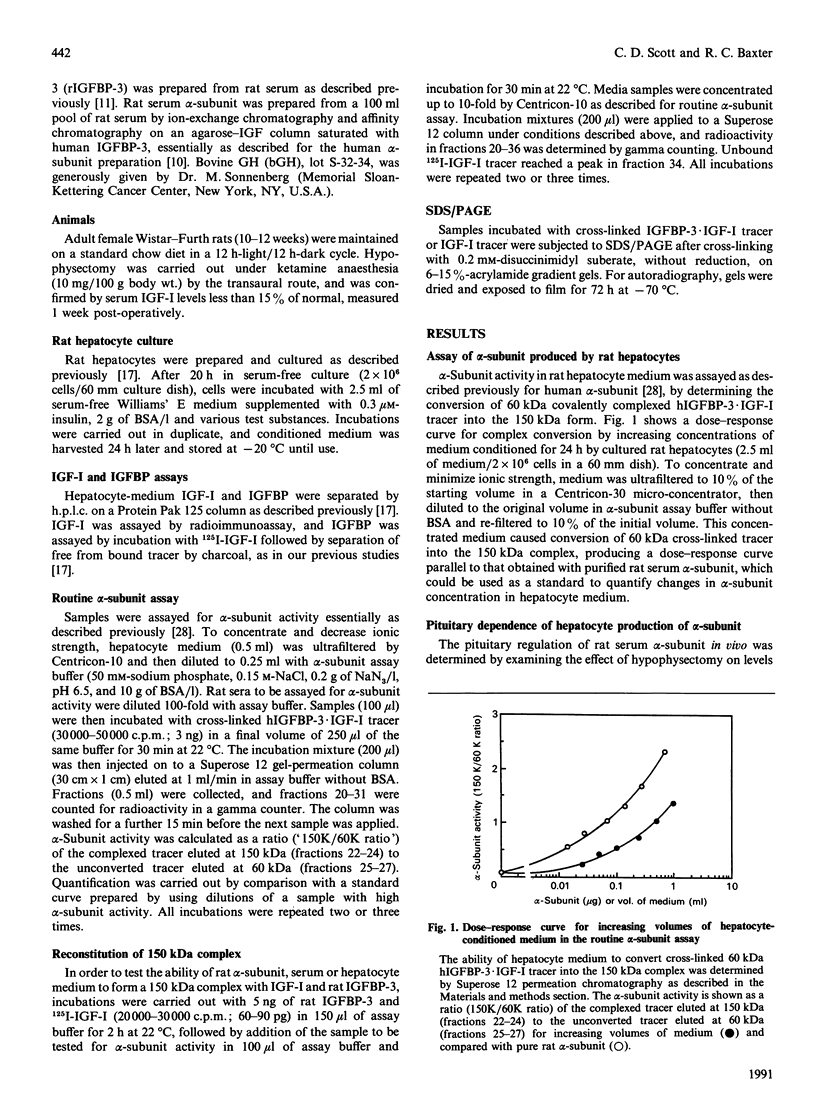
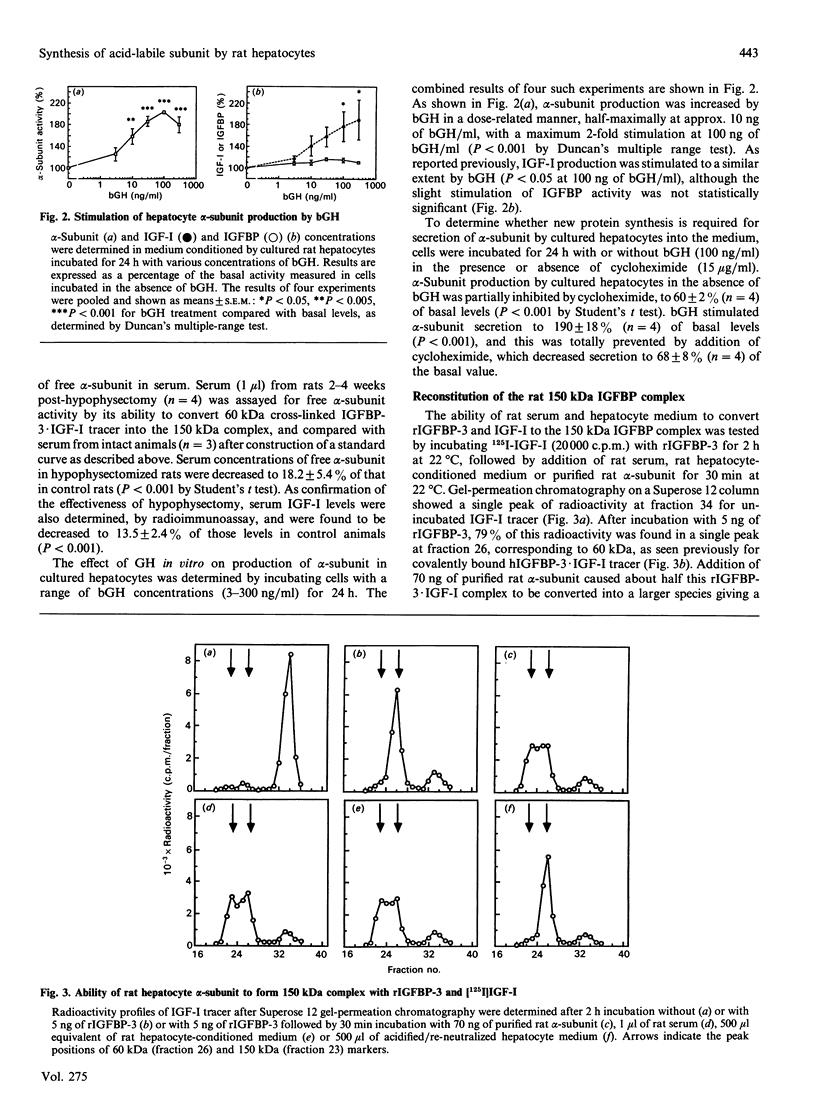
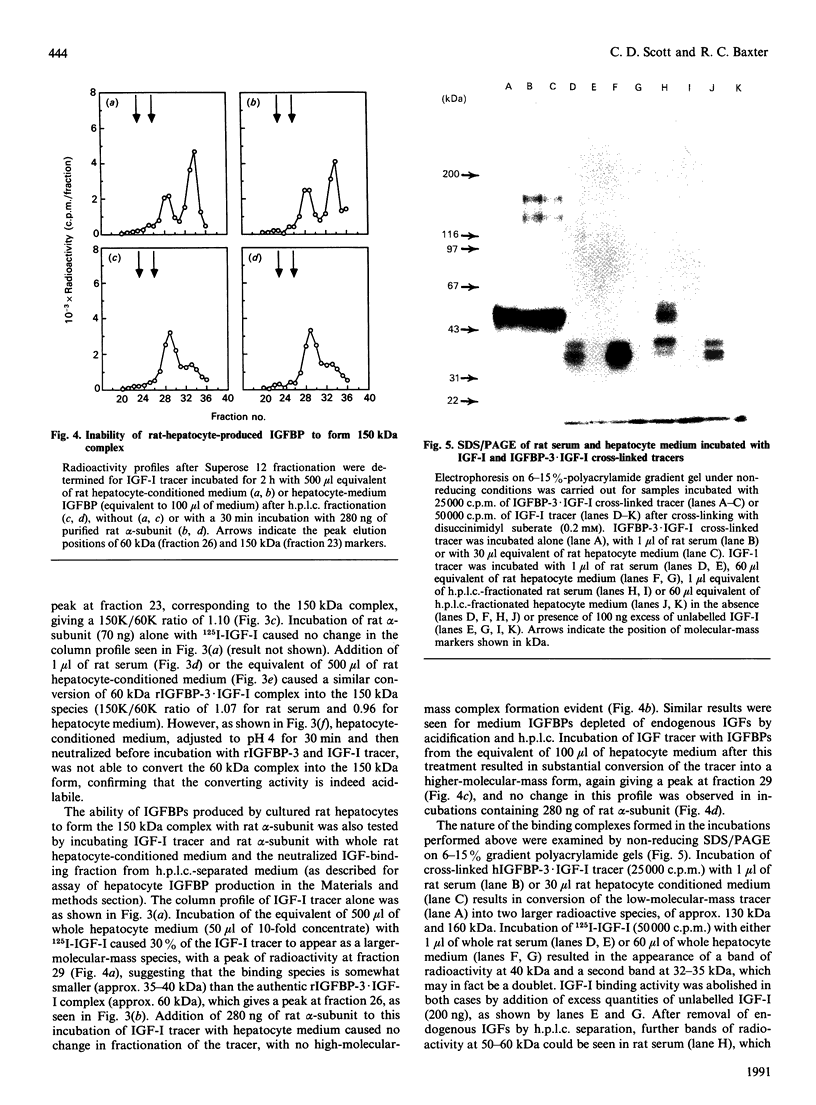
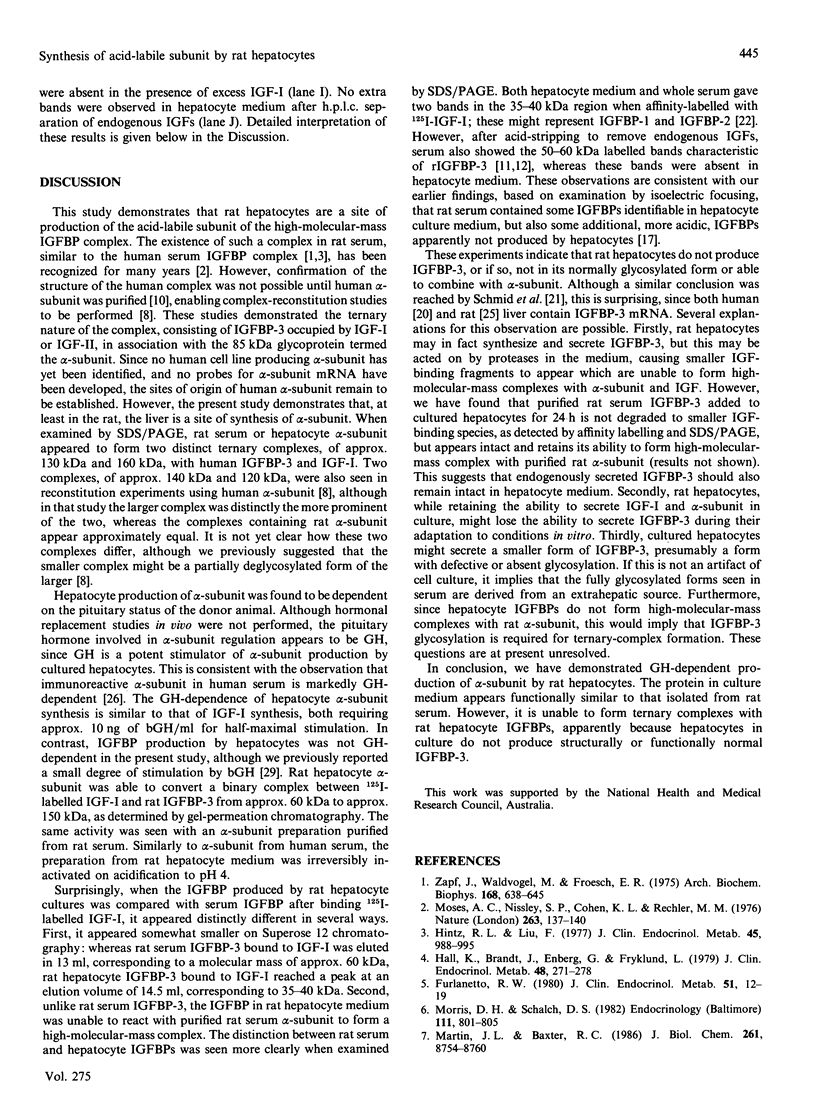
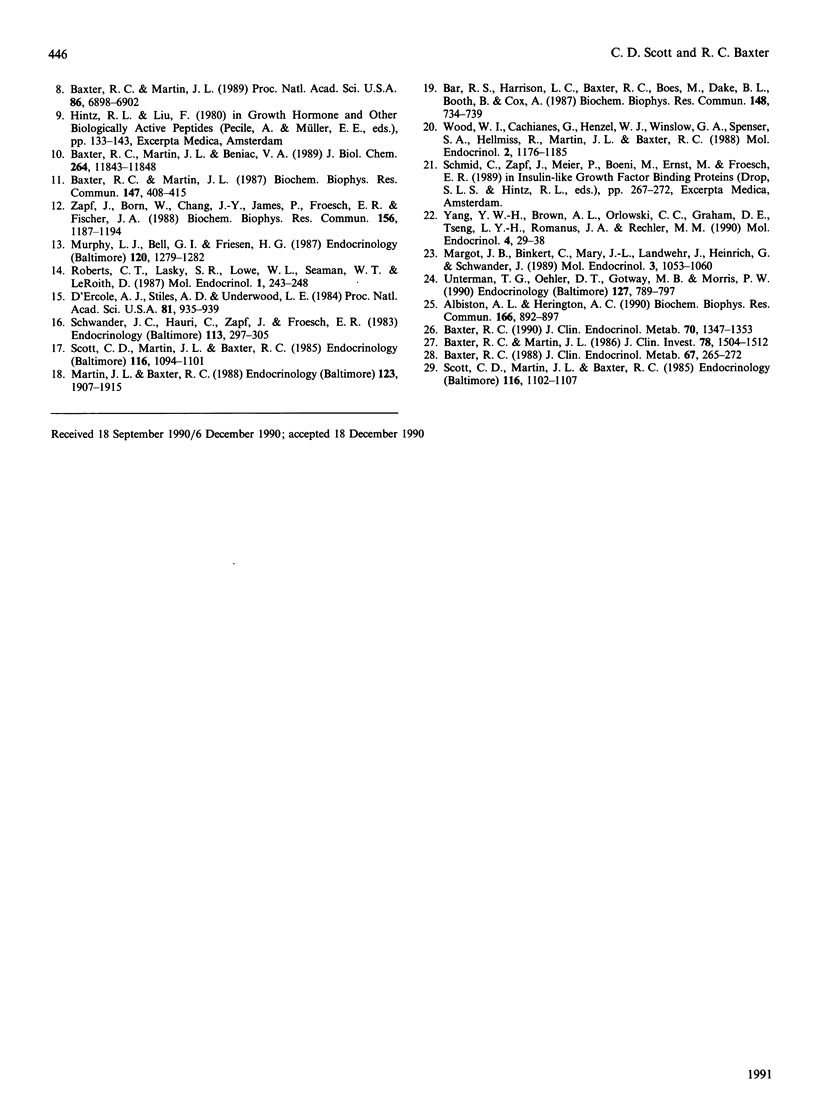
Images in this article
Selected References
These references are in PubMed. This may not be the complete list of references from this article.
- Albiston A. L., Herington A. C. Cloning and characterization of the growth hormone-dependent insulin-like growth factor binding protein (IGFBP-3) in the rat. Biochem Biophys Res Commun. 1990 Jan 30;166(2):892–897. doi: 10.1016/0006-291x(90)90894-s. [DOI] [PubMed] [Google Scholar]
- Bar R. S., Harrison L. C., Baxter R. C., Boes M., Dake B. L., Booth B., Cox A. Production of IGF-binding proteins by vascular endothelial cells. Biochem Biophys Res Commun. 1987 Oct 29;148(2):734–739. doi: 10.1016/0006-291x(87)90937-5. [DOI] [PubMed] [Google Scholar]
- Baxter R. C. Characterization of the acid-labile subunit of the growth hormone-dependent insulin-like growth factor binding protein complex. J Clin Endocrinol Metab. 1988 Aug;67(2):265–272. doi: 10.1210/jcem-67-2-265. [DOI] [PubMed] [Google Scholar]
- Baxter R. C. Circulating levels and molecular distribution of the acid-labile (alpha) subunit of the high molecular weight insulin-like growth factor-binding protein complex. J Clin Endocrinol Metab. 1990 May;70(5):1347–1353. doi: 10.1210/jcem-70-5-1347. [DOI] [PubMed] [Google Scholar]
- Baxter R. C., Martin J. L., Beniac V. A. High molecular weight insulin-like growth factor binding protein complex. Purification and properties of the acid-labile subunit from human serum. J Biol Chem. 1989 Jul 15;264(20):11843–11848. [PubMed] [Google Scholar]
- Baxter R. C., Martin J. L. Binding proteins for insulin-like growth factors in adult rat serum. Comparison with other human and rat binding proteins. Biochem Biophys Res Commun. 1987 Aug 31;147(1):408–415. doi: 10.1016/s0006-291x(87)80136-5. [DOI] [PubMed] [Google Scholar]
- Baxter R. C., Martin J. L. Radioimmunoassay of growth hormone-dependent insulinlike growth factor binding protein in human plasma. J Clin Invest. 1986 Dec;78(6):1504–1512. doi: 10.1172/JCI112742. [DOI] [PMC free article] [PubMed] [Google Scholar]
- Baxter R. C., Martin J. L. Structure of the Mr 140,000 growth hormone-dependent insulin-like growth factor binding protein complex: determination by reconstitution and affinity-labeling. Proc Natl Acad Sci U S A. 1989 Sep;86(18):6898–6902. doi: 10.1073/pnas.86.18.6898. [DOI] [PMC free article] [PubMed] [Google Scholar]
- D'Ercole A. J., Stiles A. D., Underwood L. E. Tissue concentrations of somatomedin C: further evidence for multiple sites of synthesis and paracrine or autocrine mechanisms of action. Proc Natl Acad Sci U S A. 1984 Feb;81(3):935–939. doi: 10.1073/pnas.81.3.935. [DOI] [PMC free article] [PubMed] [Google Scholar]
- Furlanetto R. W. The somatomedin C binding protein: evidence for a heterologous subunit structure. J Clin Endocrinol Metab. 1980 Jul;51(1):12–19. doi: 10.1210/jcem-51-1-12. [DOI] [PubMed] [Google Scholar]
- Hall K., Brandt J., Enberg G., Fryklund L. Immunoreactive somatomedin A in human serum. J Clin Endocrinol Metab. 1979 Feb;48(2):271–278. doi: 10.1210/jcem-48-2-271. [DOI] [PubMed] [Google Scholar]
- Hintz R. L., Liu F. Demonstration of specific plasma protein binding sites for somatomedin. J Clin Endocrinol Metab. 1977 Nov;45(5):988–995. doi: 10.1210/jcem-45-5-988. [DOI] [PubMed] [Google Scholar]
- Margot J. B., Binkert C., Mary J. L., Landwehr J., Heinrich G., Schwander J. A low molecular weight insulin-like growth factor binding protein from rat: cDNA cloning and tissue distribution of its messenger RNA. Mol Endocrinol. 1989 Jul;3(7):1053–1060. doi: 10.1210/mend-3-7-1053. [DOI] [PubMed] [Google Scholar]
- Martin J. L., Baxter R. C. Insulin-like growth factor-binding protein from human plasma. Purification and characterization. J Biol Chem. 1986 Jul 5;261(19):8754–8760. [PubMed] [Google Scholar]
- Martin J. L., Baxter R. C. Insulin-like growth factor-binding proteins (IGF-BPs) produced by human skin fibroblasts: immunological relationship to other human IGF-BPs. Endocrinology. 1988 Oct;123(4):1907–1915. doi: 10.1210/endo-123-4-1907. [DOI] [PubMed] [Google Scholar]
- Morris D. H., Schalch D. S. Structure of somatomedin-binding protein: alkaline pH-induced dissociation of an acid-stable, 60,000 molecular weight complex into smaller components. Endocrinology. 1982 Sep;111(3):801–805. doi: 10.1210/endo-111-3-801. [DOI] [PubMed] [Google Scholar]
- Moses A. C., Nessley S. P., Cohen K. L., Rechler M. M. Specific binding of a somatomedin-like polypeptide in rat serum depends on growth hormone. Nature. 1976 Sep 9;263(5573):137–140. doi: 10.1038/263137a0. [DOI] [PubMed] [Google Scholar]
- Murphy L. J., Bell G. I., Friesen H. G. Tissue distribution of insulin-like growth factor I and II messenger ribonucleic acid in the adult rat. Endocrinology. 1987 Apr;120(4):1279–1282. doi: 10.1210/endo-120-4-1279. [DOI] [PubMed] [Google Scholar]
- Roberts C. T., Jr, Lasky S. R., Lowe W. L., Jr, Seaman W. T., LeRoith D. Molecular cloning of rat insulin-like growth factor I complementary deoxyribonucleic acids: differential messenger ribonucleic acid processing and regulation by growth hormone in extrahepatic tissues. Mol Endocrinol. 1987 Mar;1(3):243–248. doi: 10.1210/mend-1-3-243. [DOI] [PubMed] [Google Scholar]
- Schwander J. C., Hauri C., Zapf J., Froesch E. R. Synthesis and secretion of insulin-like growth factor and its binding protein by the perfused rat liver: dependence on growth hormone status. Endocrinology. 1983 Jul;113(1):297–305. doi: 10.1210/endo-113-1-297. [DOI] [PubMed] [Google Scholar]
- Scott C. D., Martin J. L., Baxter R. C. Production of insulin-like growth factor I and its binding protein by adult rat hepatocytes in primary culture. Endocrinology. 1985 Mar;116(3):1094–1101. doi: 10.1210/endo-116-3-1094. [DOI] [PubMed] [Google Scholar]
- Scott C. D., Martin J. L., Baxter R. C. Rat hepatocyte insulin-like growth factor I and binding protein: effect of growth hormone in vitro and in vivo. Endocrinology. 1985 Mar;116(3):1102–1107. doi: 10.1210/endo-116-3-1102. [DOI] [PubMed] [Google Scholar]
- Unterman T. G., Oehler D. T., Gotway M. B., Morris P. W. Production of the rat type 1 insulin-like growth factor-binding protein by well differentiated H4EIIC3 hepatoma cells: identification, purification, and N-terminal amino acid analysis. Endocrinology. 1990 Aug;127(2):789–797. doi: 10.1210/endo-127-2-789. [DOI] [PubMed] [Google Scholar]
- Wood W. I., Cachianes G., Henzel W. J., Winslow G. A., Spencer S. A., Hellmiss R., Martin J. L., Baxter R. C. Cloning and expression of the growth hormone-dependent insulin-like growth factor-binding protein. Mol Endocrinol. 1988 Dec;2(12):1176–1185. doi: 10.1210/mend-2-12-1176. [DOI] [PubMed] [Google Scholar]
- Yang Y. W., Brown A. L., Orlowski C. C., Graham D. E., Tseng L. Y., Romanus J. A., Rechler M. M. Identification of rat cell lines that preferentially express insulin-like growth factor binding proteins rlGFBP-1, 2, or 3. Mol Endocrinol. 1990 Jan;4(1):29–38. doi: 10.1210/mend-4-1-29. [DOI] [PubMed] [Google Scholar]
- Zapf J., Born W., Chang J. Y., James P., Froesch E. R., Fischer J. A. Isolation and NH2-terminal amino acid sequences of rat serum carrier proteins for insulin-like growth factors. Biochem Biophys Res Commun. 1988 Nov 15;156(3):1187–1194. doi: 10.1016/s0006-291x(88)80758-7. [DOI] [PubMed] [Google Scholar]
- Zapf J., Waldvogel M., Froesch E. R. Binding of nonsuppressible insulinlike activity to human serum. Evidence for a carrier protein. Arch Biochem Biophys. 1975 Jun;168(2):638–645. doi: 10.1016/0003-9861(75)90296-9. [DOI] [PubMed] [Google Scholar]



